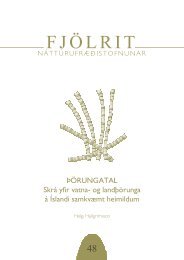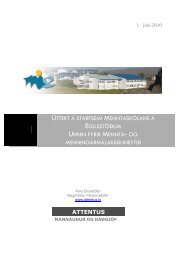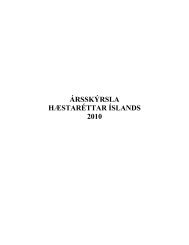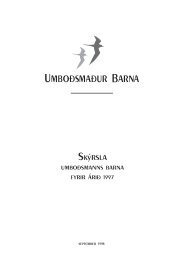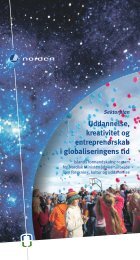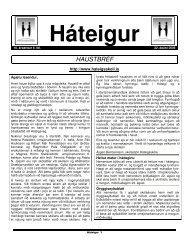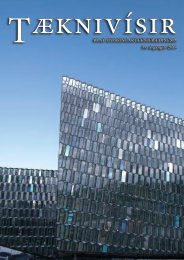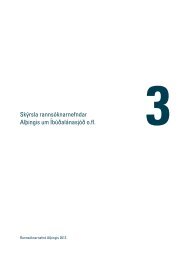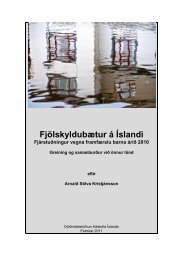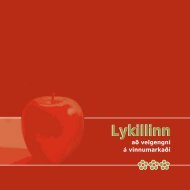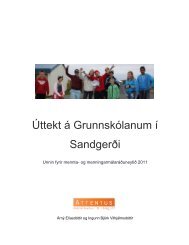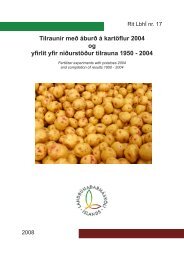Addition of collagen to heavy salted and lightly salted, chilled and ...
Addition of collagen to heavy salted and lightly salted, chilled and ...
Addition of collagen to heavy salted and lightly salted, chilled and ...
Create successful ePaper yourself
Turn your PDF publications into a flip-book with our unique Google optimized e-Paper software.
3.3–3.6% <strong>and</strong> 3.9‐4.3%, in Salt + G <strong>and</strong> Salt, respectively (Table 3). Changes in salt content with<br />
s<strong>to</strong>rage time were not significant (p >0.05).<br />
The water content was s<strong>lightly</strong> higher (p=0.08) in fillets with added gelatine. Higher content was<br />
determined with longer s<strong>to</strong>rage time (p0.05). The increases in WHC by higher salt content were in harmony with previous<br />
findings in muscle food. It is known that the WHC increases with increasing salt concentration within<br />
the muscle up <strong>to</strong> approximately 5%, due <strong>to</strong> binding <strong>of</strong> salt <strong>to</strong> muscle proteins <strong>and</strong> denaturation. At<br />
higher salt concentrations (>10‐12%), the proteins are known <strong>to</strong> aggregate, resulting in reduction <strong>of</strong><br />
WHC (Duerr <strong>and</strong> Dyer, 1952; Hamm, 1975; Offer <strong>and</strong> Knight, 1988; Offer <strong>and</strong> Trinick, 1983).<br />
Table 3. Chemical composition <strong>and</strong> water holding capacity <strong>of</strong> <strong>chilled</strong> fillets (n=3) at different sampling points<br />
(n=3) during <strong>chilled</strong> s<strong>to</strong>rage.<br />
S<strong>to</strong>rage time (days)<br />
Group 2 5 9 13<br />
Salt (%) Salt 4.3 ± 0.3 4.3 ± 0.0 3.8 ± 0.4 3.9 ± 0.1<br />
Salt + G 3.3 ± 0.1 3.3 ± 0.0 3.3 ± 0.2 3.6 ± 0.1<br />
Water (%) Salt 81.7 ± 0.6 81.5 ± 0.1 82.3 ± 0.2 82.3 ± 0.7<br />
Salt + G 81.9 ± 0.3 82.1 ± 1.0 82.5 ± 0.2 83.0 ± 0.7<br />
WHC (%) Salt 98,7 ± 0,4 99,3 ± 0,2 98,8 ± 0,1 98,8 ± 0,6<br />
Salt + G 98,8 ± 0,6 99,3 ± 0,1 98,7 ± 0,1 98,2 ± 0,4<br />
Microbial counts<br />
Results from <strong>to</strong>tal viable counts (TVC) <strong>and</strong> counts <strong>of</strong> H 2 S‐producing bacteria are shown in Figure 3<br />
<strong>and</strong> Figure 4. Very similar TVC were found whether plates were cultivated under aerobic or anaerobic<br />
conditions. This might indicate that the microbial flora was facultative anaerobic in nature, i.e. able<br />
<strong>to</strong> grow both in the presence <strong>and</strong> absence <strong>of</strong> oxygen. This was however not the case with H 2 S‐<br />
producing bacteria. The initial number <strong>of</strong> these bacteria under anaerobic conditions gradually<br />
decreased from about log 2‐3/g <strong>to</strong> levels below detection limits (





